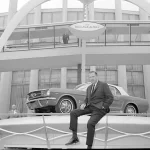
On this day in 1858 Rudolf Diesel, would later patent the type of engine by the same name, was born. In 1870, at the age of 12, Diesel and his family fled Paris for London due to the Franco-Prussian war. Before the conflict ended Rudolph’s parents sent him to stay with an aunt and uncle in Augsburg. There he became fluent in German and developed an interest in math while watching his uncle teach it. Rudolph remained in Augsburg following the conflict to study engineering. He later landed a scholarship to the Royal Bavarian Polytechnic of Munich.
After graduating in January of 1880 with the highest educational honors in his class, Rudolph moved to Paris to work for his former professor, Carl von Linde. The pair designed and constructed an ice and refrigeration plant, of which Diesel would later become the director of. A decade later Diesel moved with his wife and three kids to Berlin where he assumed management of Linde’s corporate research firm. In the years that Diesel worked for his former teacher he amassed several patents in the field of refrigeration. However, his employer contract stated he could not use these benefits outside of his work for Linde, so he branched out into other fields.

Top: Diesel on a German postage stamp with engine
Among his first engineering attempts outside of refrigerating was an ammonia vapor steam engine. Unfortunately it blew up during operational tests. The explosion resulted in a long stay in the hospital and lifelong eyesight problems.
After recovery, Diesel started designing a new engine based on thermodynamic principles and the constraints of wasted efficiency. This resulted in an experimental engine that he first debuted in 1893. The compression-ignition design required fuel to be injected at the end of compression, so it ignited when exposed to the high temperatures of the cycle. The first successful run of this new engine type occurred in 1897. That exact engine is now on display at the Deutsches Technikmuseum in Munich. For this new engine type, dubbed a Diesel engine, he received patents in Germany, the US and several other countries.
Within a decade of the successful running of the Diesel engine the world would have its first diesel ships, trucks and submarines. After Diesel’s patents expired, his engines would make their way into many other applications, including trains starting in 1912.
Rudolf Diesel Disappearance
On the night of September 29, 1913 Diesel was traveling from Dresden to Antwerp via steamship. Upon finishing dinner Diesel requested a 6:15 am wake up call for the following morning. When a steward went to wake him, he seemed to have vanished. They found his bed still made and his nightshirt laid neatly on the bed. His watch sat on the vanity and his hat and overcoat tucked neatly beneath the afterdeck railing.

Ten days later a boat spotted a body in the North Sea. The badly decomposed corpse remained in the water, but only after the sailors recovered an I.D. card and pocket knife. The items identified the remains as Diesel. A few days later another boatman found the body but also left it overboard.
It turns out the mystery began before Diesel ever boarded the ship for that fateful journey. Prior to leaving Diesel left his wife Martha a bag with directions to not open it until the following week. When she finally did open it she found 200,000 German marks, about $1.2 million today. With the cash were financial statements indicating their bank accounts now rested at zero. In Diesel’s diary, which was found on the ship, a cross was drawn for September 29, many believe it to indicate death.

There are several theories regarding his death. While his biographers make a case for suicide, some people point to murder. The latter train of thought comes from the fact Diesel refused to grant the German military exclusive rights to his invention. Furthermore, he had boarded the ship intending to meet with representatives of the British Royal Navy. He planned to strike a deal to power British submarines with Diesel engines. Evidence for any case is lacking, and his death remains unsolved.

















